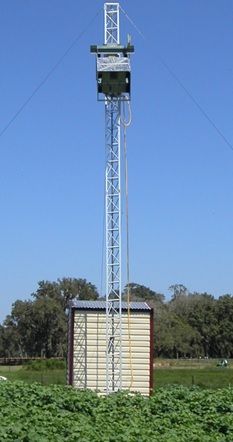Abstract
For accurate prediction of weather and near-term climate, root-zone soil moisture is one of the most crucial components driving surface hydrological processes. Soil moisture in the top meter governs moisture and energy fluxes at the land–atmosphere interface, and it plays a significant role in partitioning of precipitation into runoff and infiltration.
Energy and moisture fluxes at the land surface during growing seasons can be estimated by coupled Soil-Vegetation-Atmosphere-Transfer and crop growth models. Even though the biophysics of moisture and energy transport and of crop growth and development are well-captured in most current models, the errors in initialization, forcings, and computation accumulate over time and the model estimates of soil moisture in the root zone diverge from reality. Remotely sensed microwave observations can be assimilated in these models to improve root zone soil moisture and crop yield estimates.

Credit: J. Casanova, UF/IFAS
The microwave signatures at low frequencies, particularly at 1–4 GHz (L-band) and 4–8 GHz (C-band) are very sensitive to soil moisture in the top few centimeters in most vegetated surfaces. Many studies have been conducted in agricultural areas—such as bare soil, grass, soybean, wheat, pasture, and corn—to understand the relationship between soil moisture and microwave remote sensing. It is important to know how microwave signatures vary with soil moisture, evapotranspiration (ET), and biomass during the growing season for a dynamic agricultural canopy with a significant wet biomass of 4–12 kg/m2.
The goal of MicroWEX-10 was to conduct a season-long experiment, which incorporated active and passive microwave observations for a growing season of elephant grass and sweet corn. The variety of sensors allowed for further understanding of the land–atmosphere interactions during the growing season, and their effect on observed passive microwave signatures at 6.7 GHz and 1.4 GHz and active microwave signatures at 1.14 GHz and 1.25 GHz. These observations match that of the satellite-based passive microwave radiometers, Advanced Microwave Scanning Radiometer-2 (AMSR-2), and the Soil Moisture and Ocean Salinity (SMOS) mission, respectively, and the upcoming National Aeronautics and Space Administration's Soil Moisture Active Passive (SMAP) mission. Specific objectives of MicroWEX-10 include the following:
- To acquire simultaneous active and passive data for both elephant grass and corn.
- To collect passive and active microwave and other ancillary data to develop preliminary algorithms to estimate microwave signatures for elephant grass and corn.
- To implement alternate irrigation methods when the height of the elephant grass canopy exceeds 3 m.
- To evaluate feasibility of soil moisture retrievals using passive microwave data at 6.7 GHz and 1.4 GHz and active microwave data at 1.14 GHz and 1.25 GHz for the growing elephant grass canopy and corn.
This report describes the observations conducted during the MicroWEX-10.
More Information
To view other reports on the Microwave Water and Engergy Balance Experiments topic page: https://edis.ifas.ufl.edu/topics/microwave-radiometers